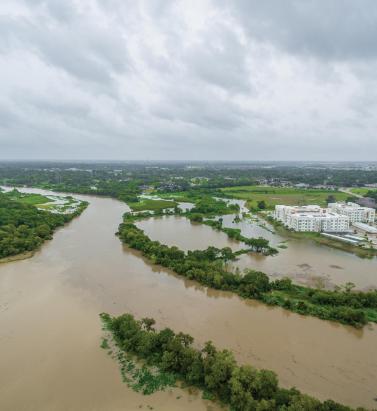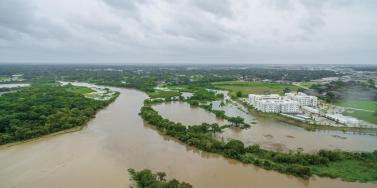Tag: PROTECTION GAP


A Need for Multi-Gap Analysis
September 06, 2019The insurance protection gap is composed of emerging markets and high-risk and intangible exposures There cannot be many industries that recognize that approximately 70 percent of market potential is untapped. Yet that is the scale of opportunity in the expanding “protection gap”. Power outage in lower Manhattan, New York, after Hurricane Sandy While efforts are ongoing to plug the colossal shortage, any meaningful industry foray into this barren range must acknowledge that the gap is actually multiple gaps, believes Robert Muir-Wood, chief research officer at RMS. “It is composed of three distinct insurance gaps — high risk, emerging markets and intangibles — each with separate causes and distinct solutions. Treating it as one single challenge means we will never achieve the loss clarity to tackle the multiple underlying issues.” High-risk, high-value gaps exist in regions where potential loss magnitude outweighs the ability of the industry to refund post-catastrophe. High deductibles and exclusions reduce coverage appeal and stunt market growth. “Take California earthquake. The California Earthquake Authority (CEA) was launched in 1996 to tackle the coverage dilemma exposed by the Northridge disaster. Yet increased deductibles and new exclusions led to a 30 percent gap expansion. And while recent changes have seen purchase uptick, penetration is around 12-14 percent for California homeowners.” On the emerging market front, micro- and meso-insurance and sovereign risk transfer efforts to bridge the gap have achieved limited success. “The shortfall in emerging economies remains static at between 80 to 100 percent,” he states, “and it is not just a developing world issue, it’s clearly evident in mature markets like Italy.” “The protection gap is composed of three distinct insurance gaps — high risk, emerging markets and intangibles — each with separate causes and distinct solutions” Robert Muir-Wood RMS A further fast-expanding gap is intangible assets. “In 1975, physical assets accounted for 83 percent of the value of S&P 500 companies,” Muir-Wood points out. “By 2015, that figure was 16 percent, with 84 percent composed of intangible assets such as IP, client data, brand value and innovation potential.” While non-damage business interruption cover is evolving, expanding client demand for events such as power outage, cloud disruption and cyberbreach greatly outpace delivery. To start closing these gaps, Muir-Wood believes protection gap analytics are essential. “We have to first establish a consistent measurement for the difference between insured and total loss and split out ‘penetration’ and ‘coverage’ gaps. That gives us our baseline from which to set appropriate targets and monitor progress. “Probabilistic cat risk models will play a central role, particularly for the high-risk protection gap, where multiple region and peril-specific models already exist. However, for intangibles and emerging markets, where such models have yet to gain a strong foothold, focusing on scenario events might prove a more effective approach.” Variations in the gaps according to severity and geography of the catastrophe could be expressed in the form of an exceedance probability curve, showing how the percentage of uninsured risk varies by return period. “There should be standardization in measuring and reporting the gap,” he concludes. “This should include analyzing insured and economic loss based on probabilistic models, separating the effects of the penetration and coverage gaps, and identifying how gaps vary with annual probability and location.”


The Future of Risk Management
May 20, 2019(Re)insuring new and emerging risks requires data and, ideally, a historical loss record upon which to manage an exposure. But what does the future of risk management look like when so many of these exposures are intangible or unexpected? Sudden and dramatic breakdowns become more likely in a highly interconnected and increasingly polarized world, warns the “Global Risks Report 2019” from the World Economic Forum (WEF). “Firms should focus as much on risk response as on risk mitigation,” advises John Drzik, president of global risk and digital at Marsh, one of the report sponsors. “There’s an inevitability to having a certain number of shock events, and firms should focus on how to respond to fast-moving events with a high degree of uncertainty.” Macrotrends such as climate change, urbanization and digitization are all combining in a way that makes major claims more impactful when things go wrong. But are all low-probability/high-consequence events truly beyond our ability to identify and manage? Dr. Gordon Woo, catastrophist at RMS, believes that in an age of big data and advanced analytics, information is available that can help corporates, insurers and reinsurers to understand the plethora of new and emerging risks they face. “The sources of emerging risk insight are out there,” says Woo. “The challenge is understanding the significance of the information available and ensuring it is used to inform decision-makers.” However, it is not always possible to gain access to the insight needed. “Some of the near-miss data regarding new software and designs may be available online,” says Woo. “For example, with the Boeing 737 Max 8, there were postings by pilots where control problems were discussed prior to the Lion Air disaster of October 2018. Equally, intelligence information on terrorist plots may be available from online terrorist chatter. But typically, it is much harder for individuals to access this information, other than security agencies. “Peter Drucker [consultant and author] was right when he said: ‘If you can’t measure it, you can’t improve it,’” he adds. “And this is the issue for (re)insurers when it comes to emerging risks. There is currently not a lot of standardization between risk compliance systems and the way the information is gathered, and corporations are still very reluctant to give information away to insurers.” The Intangibles Protection Gap While traditional physical risks, such as fire and flood, are well understood, well modeled and widely insured, new and emerging risks facing businesses and communities are increasingly intangible and risk transfer solutions are less widely available. While there is an important upside to many technological innovations, for example, there are also downsides that are not yet fully understood or even recognized, thinks Robert Muir-Wood, chief research officer of science and technology at RMS. “Last year’s Typhoon Jebi caused coastal flooding in the Kansai region of Japan,” he says. “There were a lot of cars on the quayside close to where the storm made landfall and many of these just caught on fire. It burnt out a large number of cars that were heading for export. “The reason for the fires was the improved capability of batteries in cars,” he explains. “And when these batteries are immersed in water they burst into flames. So, with this technology you’ve created a whole new peril. There is currently not a lot of standardization between risk compliance systems and the way the information is gathered Gordon Woo RMS “As new technology emerges, new risks emerge,” he concludes. “And it’s not as though the old risks go away. They sort of morph and they always will. Clearly the more that software becomes a critical part of how things function, then there is more of an opportunity for things to go wrong.” From nonphysical-damage business interruption and reputational harm to the theft of intellectual property and a cyber data breach, the ability for underwriters to get a handle on these risks and potential losses is one of the industry’s biggest modern-day challenges. The dearth of products and services for esoteric commercial risks is known as the “intangibles protection gap,” explains Muir-Wood. “There is this question within the whole span of risk management of organizations — of which an increasing amount is intangible — whether they will be able to buy insurance for those elements of their risk that they feel they do not have control over.” While the (re)insurance industry is responding with new products and services geared toward emerging risks, such as cyber, there are some organizational perils, such as reputational risk, that are best addressed by instilling the right risk management culture and setting the tone from the top within organizations, thinks Wayne Ratcliffe, head of risk management at SCOR. “Enterprise risk management is about taking a holistic view of the company and having multidisciplinary teams brainstorming together,” he says. “It’s a tendency of human nature to work in silos in which everyone has their own domain to protect and to work on, but working across an organization is the only way to carry out proper risk management. “There are many causes and consequences of reputational risk, for instance,” he continues. “When I think of past examples where things have gone horribly wrong — and there are so many of them, from Deepwater Horizon to Enron — in certain cases there were questionable ethics and a failure in risk management culture. Companies have to set the tone at the top and then ensure it has spread across the whole organization. This requires constant checking and vigilance.” The best way of checking that risk management procedures are being adhered to is by being really close to the ground, thinks Ratcliffe. “We’re moving too far into a world of emails and communication by Skype. What people need to be doing is talking to each other in person and cross-checking facts. Human contact is essential to understanding the risk.” Spotting the Next “Black Swan” What of future black swans? As per Donald Rumsfeld’s “unknown unknowns,” so called black swan events are typically those that come from left field. They take everyone by surprise (although are often explained away in hindsight) and have an impact that cascades through economic, political and social systems in ways that were previously unimagined, with severe and widespread consequences. “As (re)insurers we can look at past data, but you have to be aware of the trends and forces at play,” thinks Ratcliffe. “You have to be aware of the source of the risk. In ‘The Big Short’ by Michael Lewis, the only person who really understood the impending subprime collapse was the one who went house-to-house asking people if they were having trouble paying their mortgages, which they were. New technologies are creating more opportunities but they’re also making society more vulnerable to sophisticated cyberattacks Wayne Ratcliffe SCOR “Sometimes you need to go out of the bounds of data analytics into a more intuition-based way of picking up signals where there is no data,” he continues. “You need imagination and to come up with scenarios that can happen based on a group of experts talking together and debating how exposures can connect and interconnect. “It’s a little dangerous to base everything on big data measurement and statistics, and at SCOR we talk about the ‘art and science of risk,’” he continues. “And science is more than statistics. We often need hard science behind what we are measuring. A single-point estimate of the measure is not sufficient. We also need confidence intervals corresponding to a range of probabilities.” In its “Global Risks Report 2019,” the WEF examines a series of “what-if” future shocks and asks if its scenarios, while not predictions, are at least “a reminder of the need to think creatively about risk and to expect the unexpected?” The WEF believes future shocks could come about as a result of advances in technology, the depletion of global resources and other major macrotrends clashing in new and extreme ways. “The world is becoming hyperconnected,” says Ratcliffe. “People are becoming more dependent on social media, which is even shaping political decisions, and organizations are increasingly connected via technology and the internet of things. New technologies are creating more opportunities but they’re also making society more vulnerable to sophisticated cyberattacks. We have to think about the systemic nature of it all.” As governments are pressured to manage the effects of climate change, for instance, will the use of weather manipulation tools — such as cloud seeding to induce or suppress rainfall — result in geopolitical conflict? Could biometrics and AI that recognize and respond to emotions be used to further polarize and/or control society? And will quantum computing render digital cryptography obsolete, leaving sensitive data exposed? The risk of cyberattack was the No. 1 risk identified by business leaders in virtually all advanced economies in the WEF’s “Global Risks Report 2019,” with concern about both data breach and direct attacks on company infrastructure causing business interruption. The report found that cyberattacks continue to pose a risk to critical infrastructure, noting the attack in July 2018 that compromised many U.S. power suppliers. In the attack, state-backed Russian hackers gained remote access to utility- company control rooms in order to carry out reconnaissance. However, in a more extreme scenario the attackers were in a position to trigger widespread blackouts across the U.S., according to the Department of Homeland Security. Woo points to a cyberattack that impacted Norsk Hydro, the company that was responsible for a massive bauxite spill at an aluminum plant in Brazil last year, with a targeted strain of ransomware known as “LockerGoga.” With an apparent motivation to wreak revenge for the environmental damage caused, hackers gained access to the company’s IT infrastructure, including the control systems at its aluminum smelting plants. He thinks a similar type of attack by state-sponsored actors could cause significantly greater disruption if the attackers’ motivation was simply to cause damage to industrial control systems. Woo thinks cyber risk has significant potential to cause a major global shock due to the interconnected nature of global IT systems. “WannaCry was probably the closest we’ve come to a cyber 911,” he explains. “If the malware had been released earlier, say January 2017 before the vulnerability was patched, losses would have been a magnitude higher as the malware would have spread like measles as there was no herd immunity. The release of a really dangerous cyber weapon with the right timing could be extremely powerful.”


The Future for Flood Protection
September 05, 2018With innovation in the flood market increasing, EXPOSURE explores whether high-definition (HD) flood models are one of the keys to closing the protection gap In August 2017, Hurricane Harvey brought the highest level of rainfall associated with a tropical cyclone in the U.S. since records began, causing catastrophic flooding in some of the most populated areas of the Texas coast, including Houston. The percentage of losses attributed to inland flood versus wind damage was significant, altering the historical view that precipitation resulting from a tropical storm or hurricane is an attritional loss and highlighting the need for stochastic modeling. Total economic losses resulting from Harvey were around US$85 billion and insured losses were US$30 billion, revealing a significant protection gap, particularly where inland flood damage was concerned. Around 200,000 homes were inundated by the floods, and yet 80 percent of homes in the Houston area were uninsured. Hurricane Harvey Impacts – Aftermath An innovative catastrophe bond has suggested one way this protection gap could be reduced in the future, particularly as a private flood insurance market develops in the U.S. FloodSmart Re, which was announced at the end of July 2018, secured US$500 million of reinsurance protection on behalf of FEMA’s National Flood Insurance Program (NFIP). Reinsurer Hannover Re was acting as the ceding reinsurer for the transaction, sitting between the NFIP and its Bermuda-based special purpose insurer. “It’s a landmark transaction — the first time in history that the U.S. federal government is sponsoring a catastrophe bond,” says John Seo, co-founder and managing principal at Fermat Capital. “It’s just tremendous and I couldn’t be more excited. Events like Harvey are going to accelerate the development of the flood market in terms of risk transfer to the insurance-linked securities (ILS) market. “You have to have more efficient risk pooling and risk sharing mechanisms,” he adds. “There’s over US$200 trillion dollars of capital in the world, so there’s obviously enough to efficiently absorb event risk. So, it’s about, how do you get it out into that larger capital base in an efficient way?” While the bond only provides cover for flooding arising from named storms, either due to storm surge or rainfall, it is a “good test case for the ILS market’s appetite for flood risks,” according to ILS blog Artemis. While “it is not a broad flood coverage, it will likely help to make it more palatable to cat bond investors given their comfort with modeling the probability of named storms, tropical storms and hurricanes.” According to Cory Anger, global head of ILS origination and structuring at GC Securities, the ILS market is certainly showing an appetite for flood risk — including inland flood risk — with several catastrophe bonds completed during 2017 for European flood risk (Generali’s Lion II), Japanese flood risk (MSI and ADI’s Akibare Series 2018-1 Notes) and U.S. flood risk. “Both public and private sector entities see value from utilizing capital markets’ capacity to manage flood risk,” she says. “We think there are other geographic regions that would be interested in ILS capacity that haven’t yet tapped the ILS markets. Given the recent success of FEMA/NFIP’s FloodSmart Re Series 2018-1 Notes, we expect FEMA/NFIP to continue to utilize ILS capacity (along with traditional reinsurance capital) to support future U.S. flood risk transfer opportunities.” The ILS sector has grown significantly over the past 15 years, with deals becoming more complex and innovative over time. Many market commentators feel the market was put to the test following the major natural catastrophe losses in 2017. Not only did bonds pay out where they were triggered, fresh capital re-entered, demonstrating investors’ confidence in the sector and its products. “I’m hearing people starting to coin the phrase that 2018 is the ‘great reload,’” says Seo. “This is something I have been saying for quite some years: That the traditional hard-soft, soft-hard market cycle is over. It’s not that you can’t have an event so large that it doesn’t impact the market, but when it comes to capital markets, high yields are actually a siren call for capital. “I don’t think anyone doubts that had 2017 occurred in the absence of the ILS market it would have been a completely different story, and we would have had a traditional hard market scenario in 2018,” he adds. FloodSmart Re has clearly demonstrated the strong investor interest in such transactions. According to Anger, GC Securities acted as the structuring agent for the transaction and was one of two book runners. More than 35 capital markets investors provided fully collateralized protection to FEMA/NFIP on the landmark catastrophe bond. “The appetite for new perils is generally strong, so there’s always strong interest when new risks are brought to market,” says Ben Brookes, managing director of capital and resilience solutions at RMS. He thinks improvements in the underlying data quality along with high-definition flood models make it more likely that inland flood could be included as a peril in future catastrophe bond issuances on behalf of private insurers, on an indemnity basis. “In the early days of the cat bond market, new perils would typically be issued with parametric triggers, because investors were skeptical that sufficient data quality was achieved or that the indemnity risks were adequately captured by cat models. But that changed as investor comfort grew, and a lot of capital entered the market and you saw all these deals becoming indemnity. Increased comfort with risk modeling was a big part of that.” The innovative Blue Wings catastrophe bond, which covered insurer Allianz for severe U.K. flood risk (and some U.S. and Canadian quake) and was completed in 2007, is a good example. The parametric bond used an index to calculate flood depths at over 50 locations across the U.K., was ahead of its time and is the only U.K. flood catastrophe bond that has come to market. According to Anger, as models have become more robust for flood risk — whether due to tropical cyclone (storm surge and excess precipitation) or inland flooding (other than from tropical cyclone) — the investor base has been open to trigger selection (e.g., indemnity or parametric). “In general, insurers are preferring indemnity-triggered solutions,” she adds, “which the ILS market has concurrently been open to. Additionally, for this peril, the ILS community has been open to per occurrence and annual aggregate structures, which gives flexibility to sponsors to incorporate ILS capital in their risk transfer programs.” As the private market develops, cat bond sponsors from the insurance market would be more likely to bundle inland flood risk in with other perils, thinks Charlotte Acton, director of capital and resilience solutions at RMS. “A degree of hurricane-induced inland flood risk is already present on a non-modeled basis within some transactions in the market,” she says. “And Harvey illustrates the value in comprehensive modeling of flooding associated with named storms. “So, for a broader portfolio, in most cases, inland flood would be one piece of the picture as it will be exposed to multiple perils. However, a stand-alone inland flood bond is possible for a public sector or corporate sponsor that has specific exposure to flood risk.” With inland flood, as with all other perils, sophisticated models help to make markets. “A fund would look at the risk in and of itself in the deal, but of course they’d also want to understand the price and returns perspective as well,” says Brookes. “Models play into that quite heavily. You can’t price a bond well, and understand the returns of a bond, unless you understand the risk of it.” As the ILS market makes increasing use of indemnity protection through ultimate net loss (UNL) triggers, sophisticated HD flood modeling will be essential in order to transfer the peril to the capital markets. This allows clear parameters to be set around different hours clauses and deductible structures, for instance, in addition to modeling all causes of flood and the influence of local defenses. “It’s a landmark transaction — the first time in history that the U.S. Federal Government is sponsoring a catastrophe bond” John SEO Fermat capital Jillian Williams, chief underwriting officer at Leadenhall Capital Partners, notes that ILS is increasingly bundling together multiple perils in an effort to gain diversification. “Diversification is important for any investment strategy, as you are always trying to minimize the risk of losing large amounts in one go,” she says. “Cat bonds (144A’s) currently have defined perils, but collateralized reinsurance and private cat bonds can cover all perils. Complexities and flow of information to all parties will be a challenge for cat bonds to move from defined perils to UNL all perils. “Any new peril or structure in a cat bond will generate many questions, even if they don’t have a major impact on the potential losses,” she continues. “Investors will want to know why the issuers want to include these new perils and structures and how the associated risk is calculated. For UNL, all flood (not just sea surge) would be included in the cat bond, so the definition of the peril, its complexities, variables and its correlation to other perils will need to be evaluated and represented in the flood models used.” She thinks the potential to transfer more flood to the capital markets is there, but that the complexity of the peril are challenges that need to be overcome, particularly in the U.S. “Flood coverage is already starting to move into the capital markets, but there are many issues that need to be worked through before it can be moved to a 144A transaction in a UNL format for many territories,” says Williams. “Just one of the complexities is that flood risk may be covered by government pools. “To move flood perils from government pools to private insurers is like any evolution, it can take time, particularly if existing coverage is subsidized,” she adds. “For private insurers, the complexity is not just about flood modeling but also about ensuring risk-adequate pricing and navigating through government legislation.”


Spatial Correlation - Risk and Opportunity
July 25, 2016According to Maurizio Savina and Adrian Mark, flood risk experts at RMS, as much as 80 percent of 1-in-200 year European flood losses that impact the (re)insurance industry result from Pan-European events. Understanding the “spatial correlation” of countries more prone to simultaneous flooding is, therefore, essential in managing accumulations and identifying opportunities to diversify the risk in a portfolio. In June 2016, the severe floods that affected several European countries are expected to generate claims of up to $1.6 billion for the French market and around $1.4 billion for Germany. This follows Germany’s record year for flood losses in 2013, and a year when total economic losses for flood reached $16.5 billion across central and eastern Europe, of which $4.1 billion was insured. Those flood events demonstrate how multiple river systems can be affected, impacting more than one country, and lasting for several days or even weeks depending on regional meteo-hydrological conditions. The underlying driver of such broad flooding is often just a single weather system that produces heavy precipitation over multiple countries. “SOME NEIGHBORING COUNTRIES SHARING COMMON RIVER BASINS ARE MORE LIKELY TO BE IMPACTED AT THE SAME TIME BY A MAJOR FLOOD.” In fact, a quarter of major European flood events impact more than one country. And floods simultaneously affecting at least three European countries account for more than 90 percent of tail risk across Europe. These facts underscore the importance of understanding the correlation and diversification of risk across both basins and countries in order to accurately estimate portfolio accumulations and capital requirements. Figure 1. Spatial correlation of flood risk between London and other locations in Europe. (Source: RMS Europe Flood HD Models.) To further emphasize the point, RMS estimates that approximately 20 percent of the 1-in-200 year losses arising from portfolios in Germany and the Czech Republic are from events that impact both countries at the same time. This is a statistically significant level of spatial correlation, and a consideration for (re)insurers when managing their international portfolios. Compared to Germany and the Czech Republic, for other territories spatial correlation can be significantly lower, offering (re)insurers opportunities to diversify their flood risk. Figure 1 shows the spatial correlation of flood risk between London and all other parts of Europe. The red territories are highly correlated with London and thus more likely to be hit by common events, with yellow-to-green areas not correlated with London and southern England. By using this information a (re)insurer with a portfolio concentrated in southern England could strategically target expansion into central or eastern Europe in order to grow its portfolio while minimizing accumulations of correlated risk. Closing the Protection Gap The gap between economic losses and insured loss for flood events is a global issue. Each new major flood event further stresses the need for greater insurance penetration around the world. Europe is not immune from the issue. In markets where flood insurance is not bundled into standard insurance policies, such as in Germany, adoption of flood cover is relatively low in comparison to markets like France, Spain and the U.K. While uptake increased marginally in the aftermath of the 2013 floods, there remains a significant opportunity to close the protection gap and improve the country’s flood resilience – with models playing a key role. “A BIGGER GAP BETWEEN ECONOMIC AND INSURED LOSSES FROM THE JUNE 2016 FLOODS IS EXPECTED IN GERMANY THAN IN FRANCE DUE TO LOWER LEVELS OF FLOOD INSURANCE PENETRATION.” The success of “nat cat” schemes in these markets is one mechanism with which the industry can assist governments to close the protection gap. The U.K.’s Flood Re initiative is one example of a public-private approach whose aim is to ensure residential properties at a high risk of flood have access to affordable insurance, while lobbying for increased physical resilience through continued investment in flood defenses and mitigation measures. Catastrophe modeling is essential to the future success of such schemes and to increasing Europe’s flood resilience more generally. Risk transfer and risk mitigation require high-precision modeling across Europe to better understand the impact of Pan-European flooding. But these tools can also be used to understand the importance of investment in flood defenses and inform planning guidelines in flood-prone areas. Managing Flood Accumulations RMS Europe Inland Flood High Definition (HD) Models were developed to help the insurance industry and policymakers better evaluate the potential impact of Europe’s flood events through an improved understanding of risk accumulations, ensuring a major event does not have a disproportionate impact on a (re)insurer’s portfolio. These models simulate hydrology continuously in space and time to reproduce both temporal and spatial correlation of flood risk and offer the largest single Europe-wide event set available on the market, covering 18 river basins and 8,289 catchments over 13 countries. Maurizio Savina is a senior product manager for the RMS Europe flood models. Adrian Mark is senior product manager for RMS flood maps and data.



